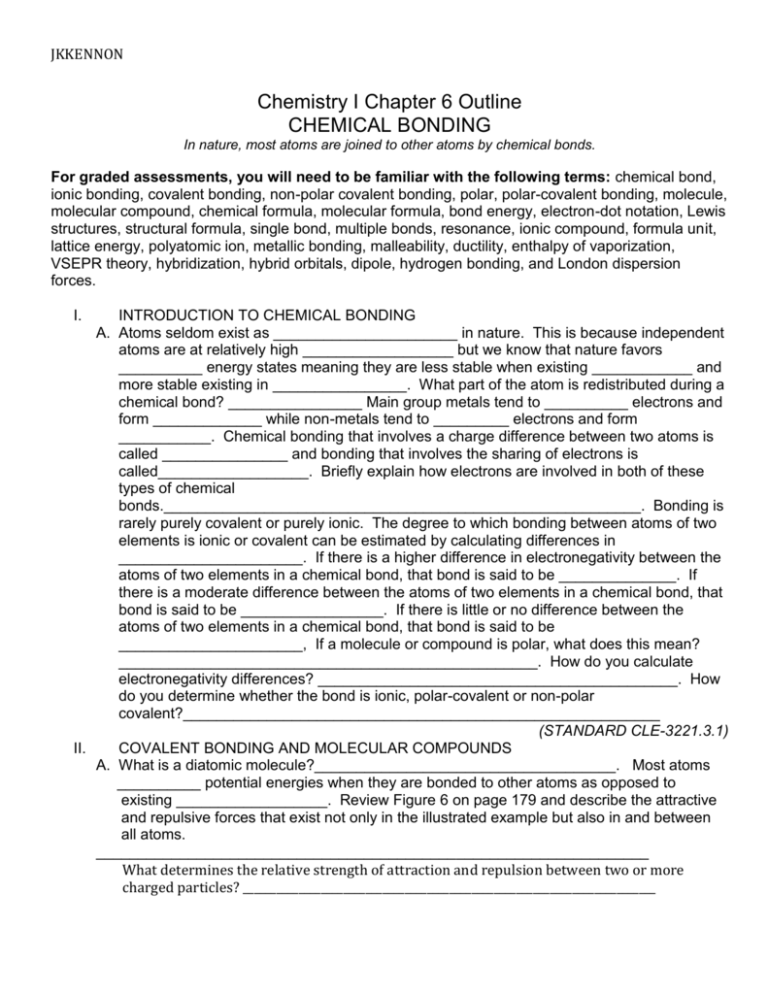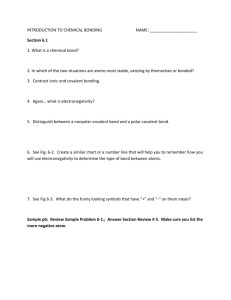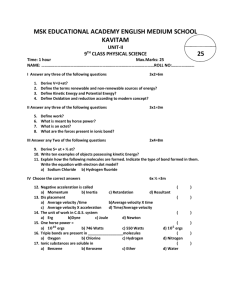Chemistry Chapter 6 Outline
advertisement

JKKENNON Chemistry I Chapter 6 Outline CHEMICAL BONDING In nature, most atoms are joined to other atoms by chemical bonds. For graded assessments, you will need to be familiar with the following terms: chemical bond, ionic bonding, covalent bonding, non-polar covalent bonding, polar, polar-covalent bonding, molecule, molecular compound, chemical formula, molecular formula, bond energy, electron-dot notation, Lewis structures, structural formula, single bond, multiple bonds, resonance, ionic compound, formula unit, lattice energy, polyatomic ion, metallic bonding, malleability, ductility, enthalpy of vaporization, VSEPR theory, hybridization, hybrid orbitals, dipole, hydrogen bonding, and London dispersion forces. I. INTRODUCTION TO CHEMICAL BONDING A. Atoms seldom exist as ______________________ in nature. This is because independent atoms are at relatively high __________________ but we know that nature favors __________ energy states meaning they are less stable when existing ____________ and more stable existing in ________________. What part of the atom is redistributed during a chemical bond? ________________ Main group metals tend to __________ electrons and form _____________ while non-metals tend to _________ electrons and form ___________. Chemical bonding that involves a charge difference between two atoms is called _______________ and bonding that involves the sharing of electrons is called__________________. Briefly explain how electrons are involved in both of these types of chemical bonds._________________________________________________________. Bonding is rarely purely covalent or purely ionic. The degree to which bonding between atoms of two elements is ionic or covalent can be estimated by calculating differences in ______________________. If there is a higher difference in electronegativity between the atoms of two elements in a chemical bond, that bond is said to be ______________. If there is a moderate difference between the atoms of two elements in a chemical bond, that bond is said to be _________________. If there is little or no difference between the atoms of two elements in a chemical bond, that bond is said to be ______________________, If a molecule or compound is polar, what does this mean? __________________________________________________. How do you calculate electronegativity differences? ___________________________________________. How do you determine whether the bond is ionic, polar-covalent or non-polar covalent?_________________________________________________________ (STANDARD CLE-3221.3.1) II. COVALENT BONDING AND MOLECULAR COMPOUNDS A. What is a diatomic molecule?____________________________________. Most atoms __________ potential energies when they are bonded to other atoms as opposed to existing __________________. Review Figure 6 on page 179 and describe the attractive and repulsive forces that exist not only in the illustrated example but also in and between all atoms. __________________________________________________________________ What determines the relative strength of attraction and repulsion between two or more charged particles? __________________________________________________________________________ JKKENNON B. What term is used to describe the average distance between two bonded atoms? _________________________ When covalent bonds are formed, _______________ is released. Why is this? ________________________________________________________ What term is used to describe the energy required to break a chemical bond and form neutral isolated atoms? ______________________ Refer to Table 1 on page 182 and describe the relationship or the proportionality between bond length and bond energy. ___________________________________________________ Do all atoms “obey” the octet rule? If not, give an example of a compound that is formed in nature that “violates” the octet rule. Refer to Figure 10 on page 184 and then cross-reference a periodic table. What trend do you notice occurs as one moves across a period (left to right)? __________________________ What is an electron-dot notation? ____________________________________________________________________________________________________________ What is a Lewis structure? _____________________________________________________________________________________________________________ How many electrons are involved in a single covalent bond?__________ How many electrons are involved in a double covalent bond? ___________ In a triple covalent bond? _______________ Which of the three types of multiple bonds have greatest bond energies? ________________ What term is used to describe a bond where molecular bonding cannot be correctly represented by a single Lewis structure?_________________________________________ (STANDARD CLE-3221.3.1) III. IONIC BONDING AND IONIC COMPOUNDS A. Most ionic compounds exist as ______________________________. A crystal is a 3-D network of _______________ and _____________ ions mutually attracted to each other. Unlike molecular compounds, ionic compounds do not exist as independent _______________________________ that can be isolated and examined. A ______________________ of an ionic compound shows the ratio of the ions present in a sample of any size. What type of ratio exists in a unit of sodium chloride? Of calcium fluoride?______________________________________________________In ionic crystals, ions minimize their potential energies by combining in an ________________________________________ known as ____________________. What is lattice energy? _________________________________________________________________________________________________________ Refer to Table 3 on page 193 and identify which compound contains the most negative (or the greatest) lattice energy of the compounds listed. _________________________ What are polyatomic ions? ________________________________________________________________________________________________ and give two examples of polyatomic ions listed in your text. __________________________________ (STANDARD 93221.3.2) IV. METALLIC BONDING A. Why are metals excellent conductors of electricity? ___________________________________________ What is electricity? _____________________________________ In metals, overlapping orbitals provide several ‘spaces’ for orbiting valence electrons around a metallic compound. This type of electron behavior is known as the _______________________________________. Why do metals reflect and absorb light the way they do, in other words, why are they generally lustrous?_______________________________________________________________________________ Metals are both ductile and malleable because ___________________________________________________________. Metallic bond strength varies with the _______________________________ of the metal atoms and the ________________________________ in the metal’s ________________________________. These two factors are reflected by a metal’s ______________________________________________. Explain, briefly, why enthalpy JKKENNON of vaporization can be used to measure the strength of a metallic bond. _____________________________________________________________________________________________________________ ____________. Of the elements listed on Table 4, page 196, which element do you expect requires the most energy to vaporize a sample of substance? ______________________ (STANDARD CLE-3221.3.1) V. MOLECULAR GEOMETRY A. Molecular properties not only depend on bonding atoms but also on_______________________________. Molecular polarity influences the forces that act ________________________________ in liquids and solids. What are the two theories that have been developed to successfully determine the shapes of molecules? _________________________ & ______________________. B. What does the acronym VSEPR stand for? _________________________________________________________________________________________. The VSEPR theory states that repulsion between the sets of ______________________________ surrounding an atom causes these sets to be oriented ______________________________ possible. Refer to your textbook on page 197 and show the Lewis dot structure formed between the atoms of Beryllium Fluoride, BeF2. What is the geometry of this molecule? ________________________________________ Now lets consider Boron trifluoride, BF3. Show the Lewis dot structure of this molecule. Then tell what geometry this molecule represents. Now consider the molecule methane, CH4. Draw the Lewis dot structure for this molecule and then indicate this molecule’s geometry. What do the bond angles measure in a linear molecule?______________ In a trigonal planar molecule?_______________ In a tetrahedral molecule?__________________ A molecule of ammonia has one set of __________________ and the bond angles in this type of molecule measures _________________. A molecule of water has ____________ sets of unshared electron pairs and the bond angles in this type of molecule measures ______________. These two molecules are not perfect tetrahedral molecules, therefore they do not perfectly each measure _____________. The reason for this is because unshared electron pairs repel electrons _______________________ than do bonding electron pairs. Give an example of an octahedral molecule ______________________________. C. The other theory used to describe molecular geometry is _______________________. It is used to describe the orbitals of an atom once arranged in a ___________________________. During hybridization, commonly, the ______ and the ______ orbitals overlap to form an ________________________ orbital. What are hybrid orbitals? __________________________________________________________________________________________________________. Review Table 6 on page 203 and memorize the types of hybridization that correspond to each type of geometry listed. D. As liquid is heated, the ___________________________ of its particles increases. At boiling point, energy is ____________________ to _____________________ forces of attraction between the liquid’s particles. Once the substance enters the gas phase, the particles have ________________________________________. Therefore, __________________________ is a good measure of the force of attraction between the JKKENNON particles in a liquid. The higher the ______________________ the stronger the attractive forces are between the molecules. What are forces of attraction between molecules called? ______________________________ Are all intermolecular forces the same for all molecules? _____________ Why or why not? __________________________________________________________________________________________________________ Referring to Table 7 on page 204, what types of substances have the highest boiling points? _________________________ and the lowest? ________________________________________ E. The strongest intermolecular forces exist between ______________________________. What creates a dipole? _____________________________________________________________ Sketch how dipoles are written when studying a molecules polarity to determine chemical behavior in a system. Of the four molecules, which 2 are polar and which 2 are nonpolar? Water, H2O; ammonia, NH3; carbon tetrachloride, CCl4; and carbon dioxide, CO2. Sketch below the dipole moments of each molecule listed and indicate why each are polar or nonpolar. What periodic trend that was studied during chapter 5 determines the polarity of a molecule? _________________________ Hydrogen bonding generally occurs between what four molecules? __________________________________________________________________________________________________________ Besides the obvious, electronegativity, why does hydrogen bonding occur? What is going on with the molecular geometry in a molecule that is capable of hydrogen bonding? What are London dispersion forces? _________________________________________________________________________________________________________________________ Below, use Figure 29 on page 207 to sketch a diagram of what occurs during a set of molecules undergoing the effects of London dispersion forces. London forces are the only intermolecular forces that act on __________________and on _________________________________. London forces increase with increasing ______________________________________. (STANDARD CLE-3221.3.1)








